字符串操作的全面总结
字符串操作看似简单,其实非常重要,不注意的话,经常出现代码运行结果和自己想要的不一致,甚至崩溃。本文总结了一些构建string对象方法、修改string对象的方法、string类型的操作函数、string类型的查找、string对象的比较。
1 构建string对象方法
首先,为了在我们的程序中使用string类型,我们必须包含头文件 。如下:
#include <string>
声明一个字符串变量很简单:
string Str;
这样我们就声明了一个字符串变量,但既然是一个类,就有构造函数和析构函数。上面的声明没有传入参数,所以就直接使用了string的默认的构造函数,这个函数所作的就是把Str初始化为一个空字符串。
String类的构造函数和析构函数如下:
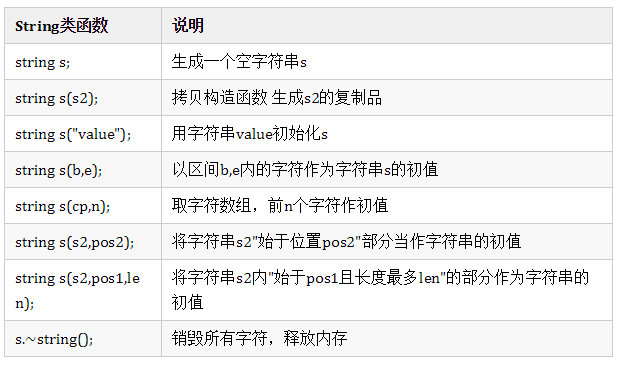
代码实例:
#include <iostream>#include <string>using namespace std;//20200527 测试字符串操作 C语言与CPP编程int main(){ string s1; cout <<s1 << endl; //没有赋值输出为空 string s2(10,'f'); cout <<s2 << endl; //用10个f定义字符串s2,输出ffffffffff string s3(s2); cout <<s3 << endl; //用s2定义上,将s3拷贝给s2,s2和s3是不同的字符串, //只是构造的时候拷贝s2,修改其中一个不会影响另一个,s3输出位ffffffffff string s4(s3.begin(),s3.begin()+(s3.size())/2); //定义s4用迭代器做参数,从第一个迭代器s3.begin() cout <<s4 << endl; //到第二个迭代器s3的一半即s3.size()/2结束,s3有10个f,s4输出为fffff char *cp = "Hello"; //最后有空字符/0 char c_array[] = "world!!!!"; //最后有空字符/0 char no_null[] = {'H','e','l','l','0'}; //最后没有空字符/0,不算C语言字符串,只是字符数组 string ss1(cp); cout <<ss1 << endl; //cp指向的字符串一个一个拷贝到ss1对象里,ssl输出为Hello string ss2(c_array,5); cout <<ss2 << endl; //c_array数组名就是指向第一个字符w的指针,从w开始取5个,ss2为world string ss3(c_array+5,4); cout <<ss3 << endl; //c_array+5指向第五个字符d,再取4个字符,ss3为!!!! //string ss4(no_null);//用字符数组为ss4赋值,因为找不到/0,不知道拷贝几个会出错 string ss5(no_null,2); //这次取2个就知道什么时候结束,不会出错 cout <<ss5 << endl; //ss5为He s1 = "Hello"; cout << s1 << endl; //s1输出Hello string s6(s1,2); cout << s6 << endl; //用s1初始化s6,2表示字符下标,从第二个字符开始到最后,s6为llo string s7(s1,0,2); cout << s7 << endl; //从s10开始取2个,s7为He string s8(s1,0,8); cout << s8 << endl; //从s1的第一个开始取8个,不够8个就结束,s8为Hello return 0;}** 运行结果**:

2 修改string对象的方法
与容器共有的 string 操作:
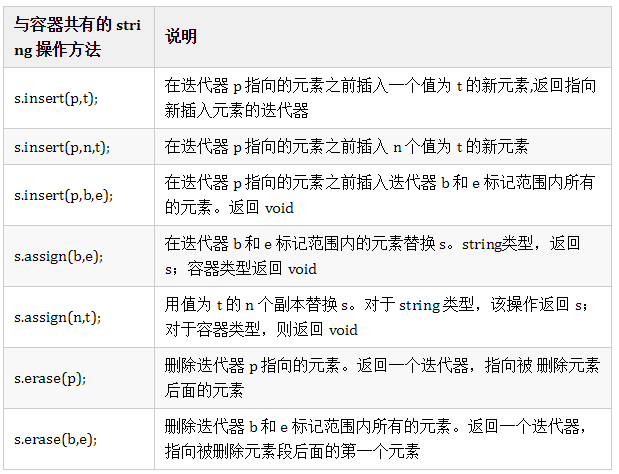
代码实例:
#include <iostream>#include <string>using namespace std;//2020.05.27 测试字符串操作 公众号:C语言与CPP编程int main(){ string s("hello"); string s2("abcdef"); string::iterator p = s.begin(); //迭代器p s.insert(p,'A'); //在迭代器p指向的s开始之前插入A cout << s << endl; //s为Ahello s.insert(p,3,'B'); //p指向返回的Ahello的A处,在A之前插入3个B cout << s << endl; //s为BBBAhello string::iterator b = s2.begin(); //迭代器b string::iterator e = s2.end(); //迭代器e //p = s.begin(); //p指向s s.insert(p,b,e); //在p指向的s之前插入b和e迭代器范围内的元素abcdef cout << s << endl; //s为abcdefBBBAhello s = "hello"; cout << s << endl; //s为hello s.assign(b,e); //s所有的元素倍替换为b到e之间的元素,b与e之间为s2 cout << s << endl; //s为abcdef s.assign(8,'K'); cout << s << endl; //s为KKKKKKKK p = s2.begin(); //迭代器p指向s2的a s2.erase(p); //删除迭代器p指向的元素a cout << s2 << endl; //s2为bcdef p = s2.begin(); //a被删除,p指向b p++; //指向c p++; //指向d string::iterator p2 = s2.end(); //p2迭代器指向f p2--; //指向e s2.erase(p,p2); //删除p指向的d和p2指向的e之间的元素 cout << s2 << endl; //s2为bcf return 0;}运行结果:
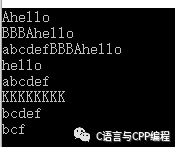
运行结果
string 类型特有的版本:
string以数组的形式存储,可以用数组的下标进行修改操作:
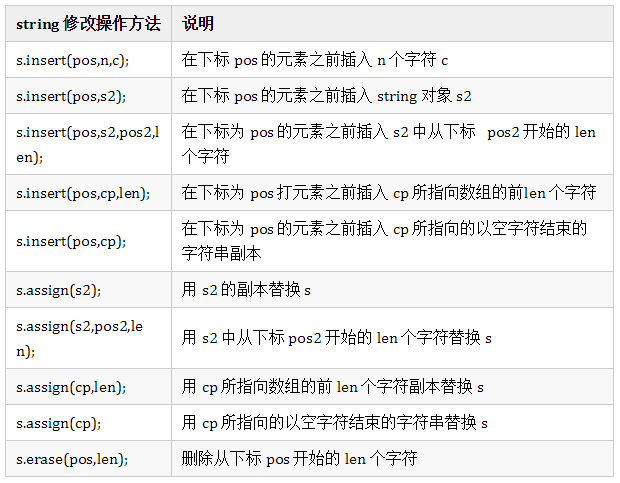
代码实例:
#include <iostream>#include <string>using namespace std;//2020.05。27 测试字符串操作 公众号:C语言与CPP编程int main(){ string s("hello"); string s2("abc"); s.insert(0,3,'A'); //在s下标是0之前插入3个A cout << s << endl; //s为AAAhello s.insert(5,s2); //在AAAhello下标是5的元素之前插入abc cout << s << endl; //s为AAAheabcllo s2 = "123456"; s.insert(0,s2,2,3); //在s的下标是0之前插入s2下标为2开始往后的3个元素345 cout << s << endl; //s为345AAAheabcllo char *cp = "Stately plup Buck"; s.assign (cp,7); cout << s << endl; //s为Stately s.assign(cp); //没有长度,默认是拷贝全部 cout << s << endl; //s为Stately plup Buck s = "hello"; s.insert (0,cp,7); cout << s <<endl; //s为Statelyhello s.insert(0,cp); cout << s <<endl; //s为Statelyhello s = "hello"; s2 = "abcdef"; s.assign(s2,2,3); //s2中下标为2开始3个元素赋值给s; cout << s <<endl; //s为cde s.assign(s2); cout << s <<endl; //s为abcdef s.erase (2,3); //从下标为2开始删除s中的3个元素 cout << s <<endl; //s为abf s = "123456789"; s.erase(s.size()-5,5); //删除s中后5个 cout << s <<endl; //s为1234 s.insert(s.size(),5,'!'); //在s下标为s.size()处,插入5个! cout << s <<endl; //s为1234!!!!! s = "abc"; s.erase(0,1).insert(0,"A"); //先从下标为0之前删除一个a为bc,再插入A cout << s <<endl; //s为Abc s = "abc"; s[0] = 'A'; //用数组的方式处理 cout << s <<endl; //s为Abc return 0;}运行结果:
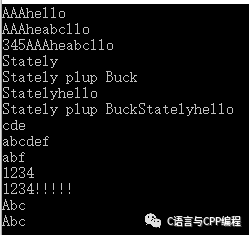
运行结果
3 适合string类型操作的函数
substr()主要功能是复制子字符串,要求从指定位置开始,并具有指定的长度。
append() 方法在被选元素的结尾(仍然在内部)插入指定内容。提示:如需在被选元素的开头插入内容,请使用prepend()方法。
replace() 该函数返回一个字符串,其中指定的字符串已经被替换为另一字符串,并且替换的次数也可以指定。
代码实例:
#include <iostream>#include <string>using namespace std;//2020.05.27 测试字符串操作 公众号:C语言与CPP编程int main(){ string s("Hello world"); string s2 = s.substr(6,5); //从第6个开始取5个 cout << s2 << endl ; //s2为world s2 = s.substr(6); //从第6个开始取拷贝所有的 cout << s2 << endl ; //s2为world s2 = s.substr(6); //s2拷贝s的全部,相当于s2=s cout << s2 << endl ; //s2为Hello world s = "C++ Primer"; s.append(" 3rd Ed"); //再s最后添加3rd Ed cout << s<< endl ; //s为C++ Primer 3rd Ed s = "C++ Primer"; s.insert(s.size()," 3rd Ed"); //最后插入 cout << s<< endl ; //s为C++ Primer 3rd Ed s.replace(11,3,"4th"); //下标11开始3个替换4th cout << s<< endl ; //s为C++ Primer 4th Ed s.replace(11,3,"Fourth"); //下标11开始3个替换Fourth cout << s<< endl ; //s为C++ Primer Fourth Ed s = "C++ Primer 3rd Ed"; //replace相当于先删除后插入 s.erase (11,3); //删除3rd s.insert(11,"Fourth"); //插入Fourth cout << s<< endl ; //s为C++ Primer Fourth Ed return 0;}运行结果:
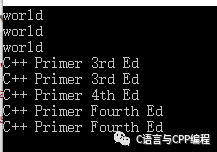
运行结果
4 string类型的查找
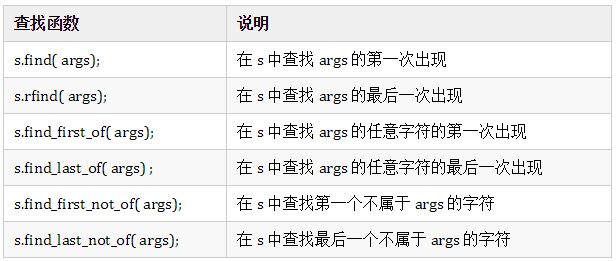
代码实例:
#include <iostream>#include <string>using namespace std;//2020.05.27 测试字符串操作 公众号:C语言与CPP编程int main(){ string name("AnnaBelle"); string::size_type pos1 = name.find("Bell"); cout << pos1 << endl; //返回下标4,如果没找到返回npos if(pos1 == string::npos) cout << "没找到!" << endl; else cout << "找到了!下标:" << pos1 <<endl; name = "2sn3"; string numerics("0123456789"); string::size_type pos = name.find_first_of(numerics); //在2sn3中查找0123456789中任意一个第一次出现 if(pos == string::npos) cout << "没找到!" << endl; else cout << "找到了!下标:" << pos <<endl; //找到了!下标:0 //其他类型的查找这里就不举例子了 return 0;}运行结果:

运行结果
5 string对象的比较
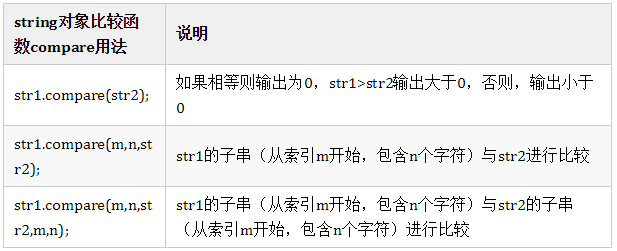
代码实例:
#include <iostream>#include <string>#include <cctype>using std::cout;using std::endl;using std::cin;using std::string;int main(void){ string str1="hi,test,hello"; string str2="hi,test"; //字符串比较 if(str1.compare(str2)>0) printf("str1>str2\n"); else if(str1.compare(str2)<0) printf("str1<str2\n"); else printf("str1==str2\n"); //str1的子串(从索引3开始,包含4个字符)与str2进行比较 if(str1.compare(3,4,str2)==0) printf("str1的指定子串等于str2\n"); else printf("str1的指定子串不等于str2\n"); //str1指定子串与str2的指定子串进行比较 if(str1.compare(3,4,str2,3,4)==0) printf("str1的指定子串等于str2的指定子串\n"); else printf("str1的指定子串不等于str2的指定子串\n"); //str1指定子串与字符串的前n个字符进行比较 if(str1.compare(0,2,"hi,hello",2)==0) printf("str1的指定子串等于指定字符串的前2个字符组成的子串\n"); else printf("str1的指定子串不等于指定字符串的前2个字符组成的子串\n"); return 0;}运行结果:

运行结果
最近原创推荐:

版权声明: 本文为 InfoQ 作者【C语言与CPP编程】的原创文章。
原文链接:【http://xie.infoq.cn/article/a36077500748694a1438864b1】。文章转载请联系作者。
C语言与CPP编程
欢迎关注微信公众号:C语言与CPP编程 2020.09.02 加入
欢迎关注微信公众号:C语言与CPP编程












评论